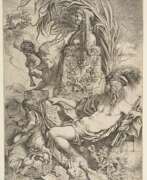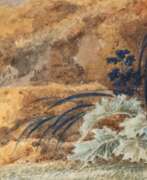Draftsmen Europe
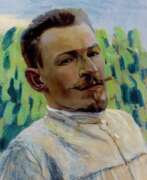

Victor Elpidiforovich Borisov-Musatov (Russian: Ви́ктор Эльпидифо́рович Бори́сов-Муса́тов) was a distinguished Russian artist celebrated for his unique contribution to the Post-Impressionist movement, combining elements of Symbolism, realism, and a decorative style that was all his own. Born in 1870 in Saratov, Russia, into the family of a former serf, Borisov-Musatov overcame early challenges, including a spinal injury that left him humpbacked, to emerge as a pivotal figure in Russian art. His education spanned the Moscow School of Painting, Sculpture and Architecture, and the Imperial Academy of Arts in Saint-Petersburg, further enriched by studies in Paris under the tutelage of Fernand Cormon. His admiration for French contemporaries, especially Pierre Puvis de Chavannes and Berthe Morisot, profoundly influenced his artistic direction.
Borisov-Musatov is renowned for his lyrical, evocative works that often depict the serene and idyllic life of the 19th-century Russian nobility, set against the backdrop of their estates. This half-illusory world, which he masterfully created, reflects a deep nostalgia and a retreat from the industrial harshness of his time. By integrating figures seamlessly into the landscapes, as seen in masterpieces like "The Pool" (1902) and "The Phantoms" (1903), he achieved a harmony that resonates with viewers for its beauty and tranquility. His use of mixed media, including tempera, watercolor, and pastel, allowed for subtle visual effects, making his works distinctive in their soft, dreamlike quality.
Borisov-Musatov's legacy extends beyond his paintings; he was a significant figure in the Russian Symbolist movement and a founding member of the Moscow Association of Artists. His works, which provide a poignant, poetic commentary on the era he lived in, are celebrated in Russian and international art circles alike. Notable paintings like "The Pool" and "The Phantoms" not only highlight his technical skill but also his ability to evoke emotion and atmosphere, making them favorites among collectors and art enthusiasts.
For collectors and experts in art and antiques, Borisov-Musatov's oeuvre offers a fascinating glimpse into the Russian Symbolist movement and the broader cultural milieu of the late 19th and early 20th centuries. His works, preserved in museums and private collections around the world, continue to enchant and inspire.
For those interested in staying informed about new product sales and auction events related to Victor Elpidiforovich Borisov-Musatov, subscribing for updates is highly recommended. This subscription ensures that enthusiasts and collectors alike will not miss the opportunity to own a piece of this remarkable artist's legacy, encapsulating the elegance and serenity that define his work.
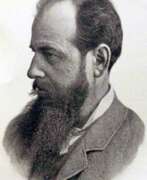

Joseph-Casimir Konstantinovich Budkevich (Russian: Иосиф-Казимир Константинович Будкевич) was a Ukrainian painter and draftsman, born on April 18, 1841, in Kyiv. Known for his battle scenes and landscapes, Budkevich studied at the Imperial Academy of Arts in Saint Petersburg, where he received several medals for his works. In 1873, he was awarded the title of Class Artist 3rd Degree.
Budkevich traveled to Italy, France, Spain, and Palestine to refine his skills. In the late 1870s and 1880s, he taught at the Kyiv Drawing School, where one of his students was Mykola Pymonenko. From 1887 to 1895, he was a member of the Kyiv Society of Art Exhibitions.
Among his notable works are "Pilgrim at the Monastery Wall" (1883) and "Jerusalem" (1894). These paintings are exhibited at the Kyiv Museum of Russian Art and the Pskov Art Gallery. His work is highly valued by collectors and art experts for its uniqueness and mastery.
If you want to receive notifications about new arrivals and auctions related to Joseph-Casimir Budkevich's work, subscribe to our updates. We will keep you informed about new sales and events related to his legacy.
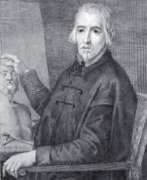

Alonso Cano was a multifaceted Spanish artist, renowned for his remarkable contributions in painting, sculpture, and architecture. Born in Granada in 1601, Cano is often celebrated as the "Spanish Michelangelo", a testament to his diverse artistic talents and significant impact on the Baroque era. His career, marked by a blend of Italian Mannerism and Baroque style, was a journey through various Spanish cities, each phase contributing uniquely to his artistic evolution.
In Seville, Cano trained under Francisco Pacheco, where his initial works like "San Francisco de Borja" (Seville Museum of Fine Arts) displayed a blend of Tenebrism and a brighter, more lyrical color palette. This period also saw the birth of works like "La Visión de San Juan" (Wallace Collection, London), signaling a transition in his style. Madrid, however, marked a significant turn in Cano's career. His works for the Buen Retiro Palace and the Alcázar showcase an evolution towards elegant, dynamic Baroque forms with lighter tonalities, influenced by the 16th-century Venetian masters.
Cano's return to Granada in 1652 was a homecoming that not only reinvigorated the Granada School but also marked his most prolific period. His masterpieces during this time include the series of paintings on the life of the Virgin in Granada Cathedral, a remarkable testament to Baroque art. Notably, his "Inmaculada Concepción" (1648) and "Nacimiento de la Virgen" (1663-1664) in the Cathedral stand as crowning achievements of his painterly career.
Equally impressive is Cano's sculptural work, where his polychrome wooden statue of the Immaculate Conception (1655) in Granada Cathedral is often hailed as his magnum opus. Despite sculpture being a secondary focus to his painting, his works, such as the Inmaculada in San Julián Church, Sevilla, and the smaller, yet exquisitely crafted, Inmaculada of the facistol in Granada Cathedral, resonate with the delicate beauty pointing towards Rococo art.
Cano's architectural prowess is exemplified in the design of Granada Cathedral's façade, an original piece of Spanish Baroque architecture. His artistic journey was not just a personal endeavor but a pivotal influence in the transition of Spanish painting towards a more idealist trend alongside Velázquez.
For art collectors and experts, Alonso Cano's works remain a cornerstone of the Baroque era, showcasing a blend of dramatic realism and spiritual depth. His influence extends beyond the boundaries of Granada, leaving an indelible mark on the world of art and culture.
To stay informed about new discoveries, product sales, and auction events related to Alonso Cano's works, sign up for our updates. This subscription focuses solely on providing relevant news in the art and antiques realm, especially concerning Cano's invaluable contributions.
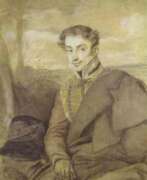

Alexander Ivanovich Dmitriev-Mamonov (Russian: Александр Иванович Дмитриев-Мамонов) was a Russian military commander and battle painter, known for his significant contributions both in the military and in the arts. Born on December 24, 1787, in Saint Petersburg, he was the son of Major-General Ivan Dmitriev-Mamonov. His early career saw him serving as an actuary at the Collegium of Foreign Affairs and later at the State Chancellery.
Dmitriev-Mamonov joined the People's Militia in 1812, rising to the rank of Lieutenant and participating in key battles such as Borodino and Krasnoi during the Napoleonic Wars. By 1823, he was promoted to Colonel and subsequently to Major-General in 1831, commanding various cavalry regiments. Apart from his military endeavors, Dmitriev-Mamonov was also an accomplished amateur artist. He co-founded the Imperial Society for the Encouragement of the Arts and established a drawing school in 1827. His battle sketches and watercolors are prominently displayed in Tsarskoye Selo.
In 1835, he transitioned to civil service, becoming a State Councillor at the Ministry of Internal Affairs. His notable awards include the Order of Saint Vladimir, Order of Saint Anna, and the Medal "For the Capture of Paris." Dmitriev-Mamonov's legacy is preserved through his artistic works and his contributions to Russian military history.
For more updates on auctions and sales related to Alexander Ivanovich Dmitriev-Mamonov's works, sign up for our newsletter to stay informed about new product sales and auction events.
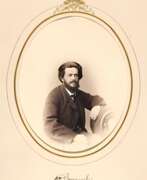

Pavel Pavlovich Dzhogin (Russian: Павел Павлович Джогин) was a Russian landscape painter, renowned for his atmospheric and detailed depictions of the Russian countryside. Born in 1834, Dzhogin captured the serene beauty of rural Russia with a meticulous eye for natural beauty and atmospheric effects.
Dzhogin's works are celebrated for their tranquility and realism, often showcasing vast skies and expansive fields. His paintings, such as "Пейзаж с рекой и рыбаком" (Landscape with a River and Fisherman), "Зимний пейзаж" (Winter Landscape), and "Вечер" (Evening), reflect his mastery of light and shadow, making his landscapes both realistic and evocative.
Notably, Dzhogin's works are held in prestigious museums, including the State Tretyakov Gallery in Moscow and the Russian Museum in St. Petersburg. His art continues to be admired by collectors and enthusiasts, offering a window into 19th-century Russian vistas. Sign up for updates on new Pavel Pavlovich Dzhogin pieces and upcoming auction events.


Nikolai Nikolaevich Ge (Russian: Николай Николаевич Ге) was a distinguished Russian painter, whose contributions to the world of art are celebrated for their emotional depth and philosophical introspection. Born in 1831, Ge's work spans a variety of themes, including religious, historical, and psychological subjects, making him a versatile artist in the realm of 19th-century Russian culture. His paintings are known not just for their aesthetic appeal but also for their ability to provoke thought and evoke deep emotions.
Ge's art is marked by its intense exploration of moral and spiritual questions, distinguishing him from his contemporaries. One of his most famous works, "The Last Supper" (1863), showcases his ability to infuse traditional religious scenes with a new level of emotional intensity and humanism. This painting, along with others like "Christ in the Garden of Gethsemane" (1868), reflects Ge's deep engagement with the themes of suffering, redemption, and the human condition. His approach to these universal subjects has earned him a special place in the canon of Russian art, making his works highly sought after by collectors and experts in art and antiques.
Ge's contributions to art extend beyond his individual works. His commitment to portraying the human experience with honesty and depth has influenced generations of artists. His paintings can be found in prestigious galleries and museums, serving as a testament to his enduring legacy. For collectors and art aficionados, Ge's work represents not only an investment in Russian culture and history but also an ongoing exploration of the depths of human emotion and spirituality.
For those interested in the profound and moving art of Nikolai Nikolaevich Ge, staying informed about new discoveries, sales, and auction events related to his work is essential. Sign up for updates to ensure you never miss an opportunity to engage with the legacy of this remarkable artist. This subscription will exclusively alert you to new product sales and auction events related to Nikolai Nikolaevich Ge, keeping you connected to the very best of Russian art and culture.
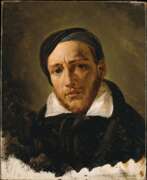

Jean-Louis André Théodore Géricault was a French painter and lithographer, celebrated for his pivotal role in the Romantic movement. Born in Rouen, France, in 1791, and educated among the elite in Paris, Géricault developed a profound connection with art from a young age, influenced by his training under notable figures like Carle Vernet and Pierre-Narcisse Guérin. This foundation set him on a path that diverged significantly from the classical traditions of his time.
Géricault's artistry is best known for its vibrant energy and emotional intensity, characteristics that marked a departure from the Neoclassical style predominant in the early 19th century. His most famous work, "The Raft of the Medusa" (1818–19), is a monumental canvas that dramatizes the tragic aftermath of the French shipwreck, Méduse, capturing the public and critical imagination for its raw portrayal of human despair and resilience. This painting not only criticized the French government but also showcased Géricault's masterful handling of drama, becoming an iconic symbol of Romanticism.
Throughout his career, Géricault remained deeply engaged with contemporary issues and the human condition, exploring themes of mental illness, social injustice, and the raw power of nature versus human vulnerability. His series of portraits depicting patients with mental illnesses, created towards the end of his life, highlighted his empathy and innovative approach to capturing human emotion and psychological depth.
Géricault's fascination with the dynamic forms and emotional potential of horses also led to some of the most stirring equestrian art of his time, reflecting his personal passion for horseback riding and his exceptional understanding of equine anatomy. This interest is evident in works like "A Horse Frightened by Lightning", showcasing his ability to capture motion and emotion in both human and animal forms.
Despite his premature death at the age of 32, Géricault's legacy endures, with his works residing in prestigious institutions like the Louvre in Paris. His artistic vision and dedication to portraying the realities and turbulences of his era have cemented his status as a pioneer of Romanticism, influencing subsequent generations of artists, including his contemporary and friend, Eugène Delacroix.
For collectors and experts in art and antiques, Géricault's oeuvre offers a profound insight into the Romantic spirit, embodying the tumult, passion, and innovation of an era on the cusp of modernity. His works continue to inspire and captivate audiences, reminding us of the power of art to provoke thought and evoke deep emotional responses.
To stay updated on exhibitions and auction events featuring Géricault's works, sign up for updates. This subscription will keep you informed on new discoveries and sales related to this influential artist, ensuring you never miss an opportunity to engage with the legacy of Jean-Louis André Théodore Géricault.
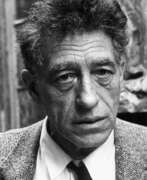

Alberto Giacometti was a Swiss sculptor, painter, draftsman, and printmaker, renowned for his distinctive elongated sculptures of solitary figures. Born in Borgonovo, Switzerland, in 1901, into a family of artists, Giacometti's talent was evident from an early age, encouraged by his father, Giovanni, a post-Impressionist painter, and his godfather, Cuno Amiet, a Fauvist painter. Moving to Paris in 1922 to study under the sculptor Antoine Bourdelle, Giacometti became a pivotal figure in Surrealism before focusing intensely on the human form, leading to his signature style of thin, elongated figures that evoke feelings of solitude and existential dread.
Giacometti's work spans several decades and various phases, including his early involvement with Surrealism and his later, more recognized existential and figurative sculptures. Notably, his sculptures, such as "Walking Man I" and "The Palace at 4 a.m.," reflect his unique view of reality and his relentless pursuit to capture the human essence. His approach was influenced by his associations with prominent figures of the art world, including Miró and Picasso, and intellectuals like Jean-Paul Sartre.
Despite facing challenges, including periods of self-doubt and the physical toll on his health, Giacometti's legacy as a master sculptor and artist remains influential. His works are celebrated worldwide and featured in major museums, such as the Museum of Modern Art in New York and the Tate Gallery in London, testament to his enduring impact on the art world.
Collectors and experts in art and antiques continue to revere Giacometti's work for its emotional depth and unique aesthetic. For those interested in the pioneering spirit of modern sculpture, Alberto Giacometti's oeuvre offers a profound exploration of the human condition and the artist's relentless pursuit of reality through art.
To stay updated on sales and auction events related to Alberto Giacometti's work, sign up for updates. This subscription is an excellent opportunity for collectors and enthusiasts to remain informed about new discoveries and opportunities related to Giacometti's enduring legacy.
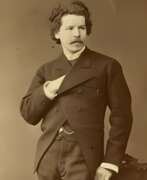

Oskar Georg Adolf Hoffmann (Russian: Оскар Адольфович Гофман) was a German painter known for his tranquil and detailed landscape paintings. Born in 1851, Hoffmann specialized in capturing the serene beauty of nature, often depicting forest scenes, rivers, and pastoral settings with remarkable precision.
Hoffmann’s work is distinguished by its meticulous attention to detail and a deep appreciation for the natural world. His paintings often feature lush greenery, reflective water bodies, and soft, diffused light, creating a sense of peacefulness and calm. Hoffmann's ability to portray the subtle nuances of light and shadow made his landscapes particularly captivating.
Some of Hoffmann’s notable works are displayed in various European museums and galleries, admired for their technical excellence and tranquil beauty. His pieces continue to attract collectors and art enthusiasts, drawn to his masterful representation of nature’s serenity.
For those interested in acquiring or learning more about Oskar Georg Adolf Hoffmann’s works, signing up for updates on new product sales and auction events is highly recommended.
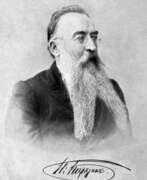

Nikolay Nikolaevich Karazin (Russian: Николай Николаевич Каразин) was a Russian military officer, painter, and writer, known for his depictions of wars and exotic places. Born in 1842 in Kharkov (now Ukraine), Karazin came from a family of prominent intellectuals, including his grandfather Vasily Karazin, who founded Kharkiv University.
Karazin's career began in the military, where he participated in campaigns against the January Uprising in Poland and in Central Asia. His firsthand experiences in battles, such as the 1868 Bukhara campaign and the 1873 Khiva campaign, greatly influenced his later work as a painter and writer. After retiring from the military, he focused on creating large canvases depicting military actions in Turkestan, as well as writing numerous adventure and ethnographic stories and novels.
Karazin's works, which include "In the Distant Confines" (1875) and "From Orenburg to Tashkent" (1886), reflect his deep engagement with the landscapes and cultures of Central Asia. His children's book "Cranes Flying South" remains popular for its vivid storytelling and illustrations. Karazin also contributed significantly to the visual arts, participating in early designs for the Moscow Metro and becoming an academician of the Imperial Academy of Arts in 1904.
To stay updated on new product sales and auction events related to Nikolay Karazin's works, sign up for our updates. This subscription will keep you informed about the latest opportunities to acquire pieces of his illustrious legacy.
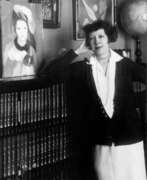

Marie Laurencin was a pivotal figure in the Parisian avant-garde, a French artist renowned for her distinct approach to painting. Unlike her contemporaries who embraced the bold facets of Cubism, Laurencin carved a niche for herself with a palette of soft pastels and a focus on ethereal female forms. Her work, embodying an enchanted, feminine world devoid of masculine presence, was revolutionary for its time, offering a sanctuary of female harmony that was both subtle and profound.
Laurencin's oeuvre extends beyond paintings to include watercolors, drawings, and prints, with notable works such as "Les jeunes filles" and "Portrait de Mademoiselle Chanel" finding homes in prestigious institutions like the Museum of Modern Art in New York and the Musée de l'Orangerie in Paris. Her legacy is further cemented by the Musée Marie Laurencin in Nagano, Japan, the only museum dedicated solely to a female painter, showcasing over 600 of her pieces.
Her approach diverged significantly from the norms of Cubism, incorporating a distinctly feminine aesthetic through the use of pastel colors and curvilinear forms. This unique style set her apart from peers and positioned her as one of the few female Cubist painters, alongside figures like Sonia Delaunay and Marie Vorobieff. Laurencin's artistry was not just an exploration of femininity but a celebration of it, challenging the dominant artistic narratives of her time.
The critique of Laurencin's work for its deliberate embrace of femininity and decorative qualities overlooks the radical essence of her aesthetic. Her paintings, characterized by serene and charming depictions of women, argue for a creative space where the feminine is not just visible but central. Works like "The Fan" and "Spanish Dancers" exemplify her ability to create intimate, self-sufficient worlds that engage the viewer in narratives of absence, longing, and female solidarity.
For collectors and experts in art and antiques, Laurencin's work offers a nuanced understanding of early 20th-century modern art movements through the lens of femininity. Her contributions to art history reflect a bold reimagining of the female form and the spaces women occupy, both in the physical and imaginative realms.
To stay informed about new product sales and auction events related to Marie Laurencin, sign up for updates. This subscription ensures you remain at the forefront of the latest developments and opportunities to acquire works by this groundbreaking artist.


Mikhail Ivanovich Lebedev (Russian: Михаил Иванович Лебедев) was a Russian landscape painter known for his captivating depictions of rural Russia and Italy. Born in 1811, he studied at the Imperial Academy of Arts in Saint Petersburg, where he developed his distinctive style influenced by the Romantic movement.
Lebedev's work is characterized by its vivid use of color and meticulous attention to detail, capturing the serene beauty of the natural world. His Italian landscapes, in particular, showcase his ability to blend realism with an almost poetic sense of atmosphere, bringing the scenic vistas to life. One of his most famous pieces, "View of Lake Nemi," exemplifies his skill in portraying light and shadow, creating a breathtakingly immersive scene.
Lebedev's paintings are celebrated for their emotional depth and technical precision. Many of his works are housed in prestigious museums, including the State Russian Museum in Saint Petersburg, allowing art enthusiasts to appreciate his contribution to landscape painting.
Sign up for updates on new sales and auction events related to Mikhail Ivanovich Lebedev. Stay informed about opportunities to acquire works by this remarkable artist.
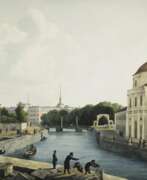

Andrey Efimovich Martynov (Russian: Андрей Ефимович Мартынов) was a Russian painter and engraver, known for his landscapes and lithographs. Born in 1768 in St. Petersburg, he graduated from the Imperial Academy of Arts in 1788. Martynov studied landscape painting under Semion Shchedrin and further honed his skills in Italy from 1788 to 1794, under the influence of Jakob Philipp Hackert. His Italian landscapes were highly appreciated upon his return to Russia, leading to his appointment as an academician in 1795.
Martynov’s work is renowned for its idealized and panoramic views of nature. He traveled extensively, capturing the beauty of rural Russia, Siberia, and Mongolia in his watercolors and lithographs. His series "Views of Russia and Mongolia" and "Peoples Types of Russia and Mongolia" are particularly admired for their detail and artistic quality. Martynov was also the official artist of the Russian embassy to China in 1805, a role that further enriched his portfolio with diverse cultural landscapes.
In addition to painting, Martynov contributed significantly to the development of lithography in Russia. His works, including scenes from the Crimea, the Baltic States, and the Volga River, are preserved in various museums, such as the Russian Museum and the Museum of the Academy of Fine Arts. Martynov’s legacy lies in his ability to blend classical composition with the celebration of natural beauty, making his works a valuable part of Russian art history.
To stay updated on new arrivals and auction events related to Andrey Efimovich Martynov, sign up for our updates. This subscription will only notify you about new product sales and auction events.
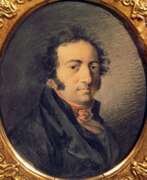

Alessandro Molinari was a German-born portrait painter of Italian ancestry, celebrated for his depictions of the Russian and Polish nobility. Born on January 5, 1772, in Berlin, and passing away on January 20, 1831, in Dresden, Molinari's artistic journey spanned various European locales. His prowess in portrait painting gained prominence during his stays in cities such as Rome, Vienna, and Saint Petersburg.
Molinari's technique and ability to capture the essence of aristocracy allowed him to become a favorite among the nobles during his time in Russia around 1806. His works often reflected a deep understanding of his subjects, infused with cultural insights that appealed to his high-society clientele. Notable pieces by Molinari include a miniature self-portrait circa 1820, showcasing his meticulous skill in this demanding medium. His legacy persists through his contributions to portrait painting, with his works displayed in prestigious institutions such as the Hermitage Museum and the Tretyakov Gallery.
For enthusiasts and collectors of classical portrait art, especially those focusing on European nobility, Alessandro Molinari's works offer a glimpse into the aristocratic life of the 18th and 19th centuries. To stay updated on exhibitions and auctions featuring Molinari's work, consider signing up for our newsletter. This subscription will keep you informed about new findings and sales directly related to Molinari, ensuring you never miss an opportunity to appreciate or acquire his timeless art.
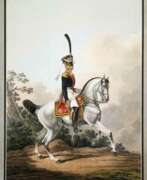

Samuel Petrovich Shiflyar (Russian: Самуил Петрович Шифляр) was a Russian painter, draughtsman, engraver, and lithographer, known for his significant contributions to portraiture and battle scenes. Born in 1786, Shiflyar initially worked for the Imperial Porcelain Factory, where he honed his skills in detailed and delicate artwork. He later joined the Military Topographic Depot of the Russian Imperial Army, where he produced numerous lithographs depicting military events and figures.
Shiflyar’s works are distinguished by their meticulous attention to detail, especially in military uniforms and battle scenes, making them valuable historical records. His piece "The Storming of Izmail" is particularly noted for its vivid depiction of the famous battle. Shiflyar's art provides a window into the military history of his time, combining artistic skill with historical accuracy.
Many of his works are housed in prestigious museums, reflecting their enduring value. Shiflyar’s pioneering efforts in lithography paved the way for future generations of Russian artists.
To stay updated on new product sales and auction events related to Samuel Petrovich Shiflyar, sign up for our newsletter.
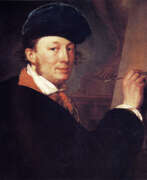

Alexander Gregoryevich Varnek (Russian: Александр Григорьевич Варнек) was a distinguished Russian painter. Known primarily for his portraits, Alexander Varnek captured the essence of figures in Russian society with a finesse that made him a notable artist of his time. He was a student under the guidance of Dmitry Levitzky and Stepan Shchukin at the Imperial Academy of Arts, where he later returned as a professor and advisor.
Alexander Varnek's artistry was celebrated for its masterful drawing, harmonious coloring, and the ability to capture close resemblances and appropriate lighting in his portraits. His conscientious execution and avoidance of embellishment in his works earned him high regard among contemporaries. Some of his notable works include portraits of Madame Khatova, Count Alexander Stroganov, and Alexey Olenin, along with other subjects like "Head of a Young Turk" and "Boy with Dog".
His life was intrinsically linked to St. Petersburg and the Imperial Academy of Arts, reflecting a career that spanned teaching, creating, and contributing significantly to Russian art. Alexander Varnek's journey included a period spent abroad in Rome, where he further honed his craft, leaving behind a legacy encapsulated in his portraits and other artworks that continue to be celebrated in the world of art.
For collectors and experts in art and antiques, Alexander Grigorievich Varnek's body of work offers a glimpse into the rich tapestry of Russian portraiture and its evolution during his lifetime. To delve deeper into his life and explore his creations, consider signing up for updates related to Varnek and stay informed about exhibitions, sales, and auctions of his works.
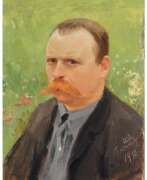

Ivan Alexeyevich Vladimirov (Russian: Иван Алексеевич Владимиров) was a Russian painter and graphic artist, known for his vivid and often stark depictions of the Russian Revolution and its aftermath. Born on January 10, 1870, in Vilnius, Vladimirov became a prominent war artist, documenting the turbulent events of early 20th-century Russia through his art.
Vladimirov's artistic journey began with formal studies at the Vilna Drawing School and later at the St. Petersburg Academy of Arts. His early works focused on battle scenes and everyday life, showcasing his realistic style and attention to detail. During the Russo-Japanese War and World War I, he served as an artist-correspondent, capturing the brutal realities of war.
His most notable works were created during and after the Russian Revolution. Paintings like "On the Streets of Petrograd" and "Hungry Times in Petrograd" portray the harsh conditions and social upheaval of the era. Vladimirov's art provides a critical lens on the revolution, illustrating both the triumphs and tragedies of the period. His works are housed in various collections, including the Williamson Art Gallery & Museum.
To stay updated on new exhibitions and auction events related to Ivan Alexeyevich Vladimirov, sign up for our newsletter. You'll receive timely alerts on new product sales and special events related to this influential artist.
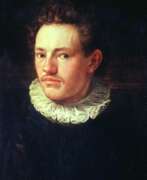

Hans von Aachen was a German painter, renowned for his role as a leading representative of Northern Mannerism. His journey into the art world took him from Rome, where he studied antique sculptures and the works of Italian masters, to Florence and then Venice, securing commissions that would define his early career. Notably, his work caught the attention of the Medici family, leading to significant commissions.
By 1592, von Aachen had become the official painter for Emperor Rudolf II in Prague. This position didn't require him to stay at court, allowing him to work from his residence. His relationship with Rudolf II was pivotal, marking a period where his art flourished under the emperor's patronage, celebrated for mythological paintings and complex allegories. The emperor's appreciation for painting and the arts transformed Prague into a significant art center, fostering a style full of elegance and sensuality known as Mannerism.
Hans von Aachen's style, influenced by Italian Mannerism and northern realism, showcased his versatility through portraits, historical, religious subjects, and allegories. His significant works include the "Allegory of Peace, Art and Abundance," depicting personifications of Peace, Science and the Liberal Arts, and Abundance, celebrated for illustrating the flourishing of these ideals under Rudolf II's reign. This piece, among others, found its home in prestigious collections like the Hermitage Museum in Saint Petersburg.
His contribution to the art world was acknowledged by the European courts, merchants, and the nobility. Even after Rudolf II's death, Hans von Aachen continued his work for Matthias, focusing on imperial portraits until his death in Prague in 1615. His legacy, momentarily overshadowed by the nationalistic perspectives of the 19th century, has been reevaluated, recognizing him as a key figure in European cultural exchange and Mannerism.
For art collectors and experts interested in Mannerism and Hans von Aachen's work, his journey from an admired artist at European courts to a celebrated figure in art history underscores the lasting impact of his work. His ability to navigate the cultural and artistic demands of his time, leaving behind a body of work that continues to be studied and appreciated, makes him a fascinating subject of study.
For updates on new product sales and auction events related to Hans von Aachen, sign up here. This subscription is your gateway to exploring the remarkable works of this distinguished Mannerist painter, ensuring you never miss an opportunity to own a piece of history.
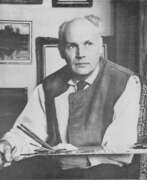

Vasily Prokofyevich Yefanov (Russian: Василий Прокофьевич Ефанов), a Soviet and Russian painter born on November 23, 1900, in Samara, and passing away on March 3, 1978, in Moscow, was not just an artist but also an esteemed pedagogue. In 1965, his contributions to art were recognized when he was honored as the People's Painter of the USSR. Yefanov's artistry was deeply intertwined with the socio-political fabric of his time, often reflecting the ideals of socialist realism. This style was not just a mode of artistic expression but served as a vehicle for ideological communication, emphasizing the heroic in everyday life and the monumental achievements of the Soviet people.
Yefanov excelled particularly in portraiture, where his talent for capturing the essence of his subjects shone brightly. His notable works include "The Unforgettable Meeting" (1934), "A Street Fight" (1942), and the "Portrait of Pyotr Leonidovich Kapitsa" (1958), each a testament to his skill in depicting significant historical moments and prominent figures of his era. His mastery over various mediums — including sangina, charcoal, pencil, watercolor, and pastel — allowed him to create a vast and diverse body of work that spanned thematic pictures, landscapes, and group portraits.
Yefanov's work provides a window into the cultural and political landscape of the Soviet Union during its most transformative years. His portraits, in particular, offer a gallery of faces that represent the diverse strata of Soviet society, from workers and soldiers to academics and artists, all imbued with the spirit of their times. Through his detailed and sensitive approach, Yefanov not only documented his era but also contributed to the rich tapestry of Soviet art, leaving a legacy that continues to be celebrated and studied for its historical significance and artistic merit.
For collectors and experts in art and antiques, Vasily Yefanov's oeuvre offers a fascinating insight into the world of Soviet art. His pieces are not just artworks but historical documents that capture the essence of an era. If you are interested in updates on sales and auction events related to Yefanov's work, signing up for newsletters from galleries and auction houses specializing in Soviet art can provide valuable alerts to new opportunities to acquire pieces by this distinguished artist.
